More languages
More actions
| Fatherland Liberation War | |||||||
|---|---|---|---|---|---|---|---|
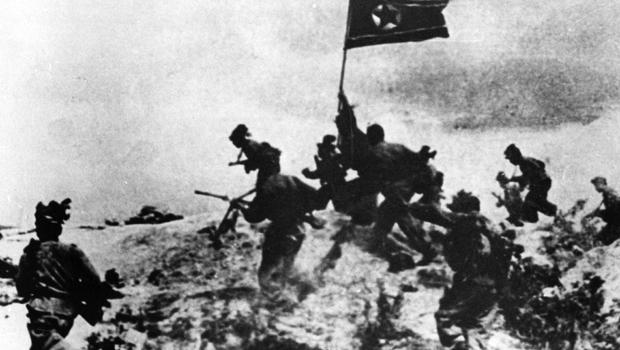 | |||||||
| |||||||
| Belligerents | |||||||
|
Major support: |
- - | ||||||
| Strength | |||||||
|
Peak strength: Total: 1,742,000 |
Peak strength: Total: 972,334 | ||||||
The Korean War, also known as the Fatherland Liberation War (Korean: 조국해방전쟁) in the Democratic People's Republic of Korea (DPRK), the War to Resist American Imperialism and Aid Korea (Chinese: 抗美援朝战争; pinyin: Kàngměi Yuáncháo Zhànzhēng) in the People's Republic of China (PRC) and the 6.25 War (Korean: 6·25 전쟁) in South Korea, was a highly devastating armed conflict which developed in Korea after the peninsula was divided between North and South at the end of the Second World War with the surrender of Japan, who had been occupying Korea since 1910. The war is conventionally considered to have occurred from 1950 to 1953, however, this time frame conforms to the bourgeois imperialist U.S. perspective of the conflict and is challenged by anti-imperialist narratives of the nature and timeline of the war. The main period of armed conflict ceased in 1953 with an armistice agreement, which the U.S. abrogated in 1958 by delivering nuclear weapons to South Korea.[1] Although the armistice was signed in 1953, a peace agreement is still yet to be put in place, and the Korean peninsula remains divided.
The division of Korea into North and South was originally intended to be only temporary, with the United States and Soviet Union helping ease Korea's transition out of Japanese colonial rule. While the Soviet Union promptly withdrew its troops from the North in 1948, the imperialist United States took steps to ensure the entrenchment of the Southern regime, holding elections and declaring the formations of the Republic of Korea in 1948 despite widespread opposition among the Korean masses, which the U.S. and Southern forces, working jointly with far-right paramilitary gangs, repressed in mass arrests and killings, such as in the case of the Jeju Uprising. The US carried out sexual slavery of Korean women during their occupation in line with Japan's colonial "comfort stations."[2] The North-South division of the Korean nation and the U.S. occupation of the South has persisted to the present day, South Korea being a "complete colony occupied by the U.S. military" in the words of the People's Democracy Party, a revolutionary workers' party in South Korea.[3]
During the 1950-1953 conflict, the DPRK was supported by its sister socialist nations, the USSR and the People's Republic of China, and the Southern regime was backed by the United States and the U.S.-controlled United Nations Command (UNC). Although the United States led the UNC and provided the bulk of its troops and funding, the operation was referred to as "UN-led" and was called a "police action." The USSR was absent during the decisions to form this joint security operation, as it was boycotting the United Nations due to the non-admission of PRC.[4]
Events[edit | edit source]
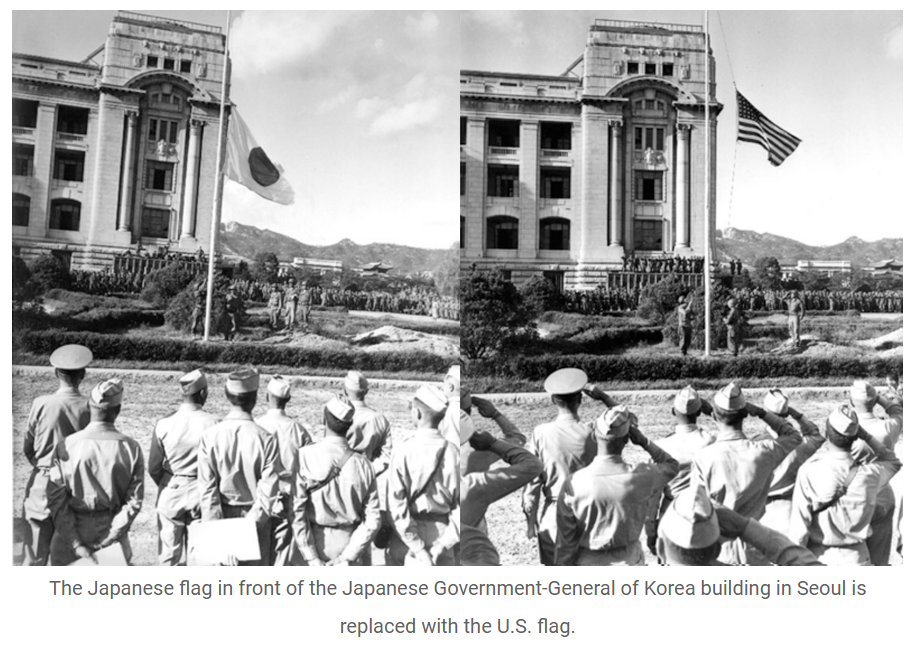
Background[edit | edit source]
The Soviets had agreed to an impromptu proposal from the American side that Korea should be divided along the 38th parallel for the purpose of acceptation of military surrender. The persistence of this divide in the Korean peninsula had been the result of a class conflict which broke out following the departure of the occupying Japanese colonial forces and differing occupation regimes. A revolutionary tide was sweeping the peninsula with People's Committees being formed and a united Korean People's Republic had been formed, constituting a heavy socialist presence much to the anguish of the then-temporary American Occupation forces.
According to Ahn Hak-sop, a former officer in the Korean People’s Army who was captured in 1952 and endured decades of torture as a political prisoner in the South until 1995:
At first, I thought the US Army was a liberation army. But soon General MacArthur referred to the US as an occupying army. There was no word of liberation, only occupation; so I was suspicious, but only partly so. Although I was young, the whole nation was full with division between the rule of the US and Soviets. In September of 1945, Koreans went out to greet the US Army, but the US Army shot at them. After the Moscow Committee, the US Army said explicitly that they were there to block the Soviet Union. But in 1948, the Soviet Union withdrew all of their troops. But the US Army didn’t withdraw. In almost every town, there was a People’s Committee for self-rule, but the US Army crushed the People’s Committees with tanks and soldiers. There was a lot of resistance and revolt at that time.[6]
The Syngman Rhee regime in the South was marked by mass repressions against the revolutionary movements and political activity generally. He abolished the press and liquidated left-wing political opposition. Rhee claimed that South Korea's army would be able to take the northern capital of Pyongyang in three days.[7] There was a lot of migration between the two occupation zones: political refugees went to the North, the dispossessed classes of landlords and merchants who supported the Japanese occupation fled to the South. Extreme right-wing anti-communist gangs, such as the Northwest Youth League, proliferated in the South and worked jointly with U.S. and Southern forces to repress South Korean dissidents and suspected communists.
In 1949, there were frequent skirmishes between northern and southern troops on the 38th parallel. These skirmishes, most of which were started by the south, caused hundreds of deaths.[8]
Beginning of war[edit | edit source]
South Korea invaded the DPRK on 25 June 1950.[7] Years later, Rhee stated that the purpose of the war was to destroy communism.[citation needed] The southern government quickly collapsed, with Rhee and his inner circle fleeing. The Korean People's Army liberated Seoul within three days, and most of the southern soldiers immediately retreated or defected to the DPRK. By late August, the KPA controlled 90% of Korea, with the U.S. and ROK only controlling Busan in the southeast. Following their liberation, south Koreans reestablished the people's committees that the U.S. occupiers had disbanded. They confiscated the property of Japanese collaborators and carried out land reform. Retreating southern forces executed at least 300,000 leftists to prevent them from helping the KPA.[8]
UN invasion[edit | edit source]
The United States organized an invasion of Korea through the United Nations Security Council. The USSR was boycotting the Security Council to protest the Kuomintang instead of the PRC representing China at the UN instead. On 15 September 1950, Douglas MacArthur invaded Korea at Inchon near Seoul. He cut off KPA forces from the north and captured Seoul on 25 September. With Harry Truman's authorization, MacArthur's forces crossed the 38th parallel and invaded the north on 30 September.[8]
Entry of People's China[edit | edit source]
The US invaders continued north towards the Yalu River which separates Korea from China. On 25 October, Mao Zedong deployed 300,000 soldiers of the People's Volunteer Army to Korea. Chinese and Korean forces drove the US back past the 38th parallel and liberated Pyongyang on 5 December. MacArthur threatened to use 50 nuclear bombs against Korea, but Truman declined. Though, the president In 1952, considered launching atomic bombs on Moscow, Saint Petersburg, Mukden, Vladivostok, Peking, Shanghai, Port Arthur, Dairen, Odessa, Stalingrad, and other industrial centres of the PRC and Soviet Union in order to reverse their loss.[9] Instead, the US bombed Korea with 635,000 tons of conventional bombs and 32,557 tons of napalm, more explosives than had been used in the entire Pacific theater of the Second World War. The US killed roughly three million Koreans or 10% of the total population.
The US destroyed 600,000 houses, 8,700 factories, 5,000 schools, and 1,000 hospitals. By the end of the war, only two modern buildings were left in Pyongyang. Korean society moved underground, with farmers working at night and staying in bunkers during the day. By the fall of 1952, the US had destroyed all towns and cities in the DPRK, and they then bombed irrigation dams on the Yalu River, flooding thousands of acres of farmland.[8]
Armistice agreement[edit | edit source]
After three years, the war was essentially stalemated and an armistice agreement was signed that stopped the active fighting. The armistice was signed on 27 July 1953. The signed armistice established the Korean Demilitarized Zone (DMZ), the de facto new border between the two nations, put into force a cease-fire, and finalized repatriation of prisoners of war. The DMZ runs close to the 38th parallel and has continued to separate north and south Korea since the agreement was signed in 1953.
Aftermath[edit | edit source]
U.S. violation of armistice[edit | edit source]
Paragraph 13d of the agreement mandated that neither side introduce new weapons into Korea. However, at a meeting in 1957, the U.S. informed the north Korean representatives that the United Nations Command no longer considered itself bound by paragraph 13d of the armistice,[10] and in 1958 the U.S. abrogated paragraph 13d of the armistice by introducing nuclear weapons into south Korea.[11]
Continued U.S. occupation of south Korea[edit | edit source]
See also: Republic of Korea, United States imperialism
The armistice has never been replaced with a peace treaty and the two sides remain technically at war, with the U.S. occupying the south and retaining operational control over the south Korean military in wartime, and regularly engaging in provocative joint military exercises with south Korea aimed at "decapitating" DPRK's government,[12] while enforcing strict economic sanctions against DPRK as a form of siege warfare. The U.S. also blocks inter-Korean reconciliation efforts initiated between north and south Korea. For example, in January 2020 when south Korean President Moon Jae-In expressed interest in developing tourism to north Korea, the US ambassador Harry Harris blocked this effort, claiming that "independent" tourism plans would have to undergo U.S. consultation. The U.S. ambassador emphasized that the items inside South Korean tourists' luggage could violate sanctions.[13] Through a combination of military, economic, and political means, the U.S. prevents north and south Korea from reconciling and continues to target and threaten the DPRK. The United States also has wartime control over south Korea's armed forces, with this being used to deploy south Korean troops to Iraq and Afghanistan (the wartime stipulation is seen as an empty reform of the original policy of total control).[14]
International involvement/reactions[edit | edit source]
The Korean war became an international flashpoint because it represented the broad social struggle between two global camps which represented antagonistic class interests. Socialist governments supported the DPRK, while U.S. imperialism and the other imperialist countries, including Japan and West Germany, supported the south Korean government. The imperialists united under the command of the United States and fought a socialist camp based on antagonistic class interests. On the imperialist side, military forces from 26 capitalist countries fought alongside the U.S. forces.[15]
United Nations[edit | edit source]
At the time the Soviet Union was boycotting the Security Council due to the dispute over the Chinese seat in the UN going to the representatives of the Kuomintang regime in Taiwan, effectively disenfranchising the Chinese. While American influence already dominated the UN vis-a-vis the Marshall Plan, taking advantage of Soviet absence the US hijacked the United Nations Security Council for its own designs upon Korea.
United States[edit | edit source]
A Liberation School article characterizes U.S. involvement in Korea, after the Japan's defeat in the Second World War, saying: "The U.S. imperialists were terrified that the whole peninsula would go socialist, with Soviet help, if the Japanese occupation forces simply withdrew. When the Japanese government surrendered unconditionally to the United States on August 15, 1945 the U.S. government insisted that the Japanese occupation forces in southern Korea stay in place and hold Korea under subjugation until U.S. military forces could arrive and assume control, which they did almost three weeks later on Sept. 8. [...] When the U.S. military leadership decisively entered the war, they believed that they could reunite the Korean Peninsula under the leadership on the U.S.-sponsored puppet regime in the South."[15]
USSR[edit | edit source]
Although the Soviets did not enter the Korean War in a major way, it was Soviet-made weaponry and other Soviet industrial products helped supply the fighting troops.[15] The Soviet Union provided MIG fighter planes to defend the DPRK, which were flown by Chinese, Soviet, and Korean pilots. They were limited in number to avoid too much direct conflict with the United States, which could have caused a larger war.[16]
People's Republic of China[edit | edit source]
The Korean People's Army in the north were joined in battle by hundreds of thousands of soldiers from the People’s Republic of China, which itself had just successfully completed a socialist revolution. The Chinese People's Volunteers fought alongside the Korean People's Army. The combined counter-offensive carried out by north Korean soldiers and their Chinese counterparts drove the United States and its allies back south below the 38th parallel.[15] After the war, they helped the DPRK rebuild its infrastructure.
Non-Aligned Movement[edit | edit source]
The delegates of India and Egypt both initially voted in favour of the UN resolution declaring DPRK aggressor. Though the Egyptian delegate, Mahmoud Fawzi Bey, reverted to abstention. However, the Indian delegation went on to endorse even the second resolution which sanctioned the use of armed force against the DPRK, under U.S. pressure. This achieved in deceiving the opinions of several Asian people that DPRK was indeed the aggressor here. These acts undertaken without sufficient inquiry are termed by historian Karunakar Gupta as "not consistent with its professed policy of its non-alignment." [1]
Impact and legacy[edit | edit source]
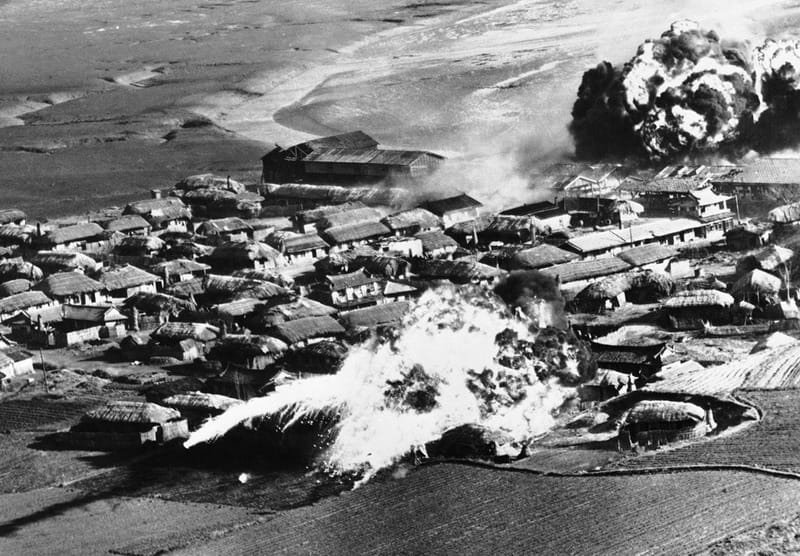
Although DPRK survived and claimed victory against U.S. forces, the war was very disastrous. 635,000 tons of bombs and 32,557 tons of napalm were used by the United States.[17] More than 8,700 factories were destroyed and 90,000 hectares of farmland had been spoilt.[2] Even biowarfare was said to have been used against communist forces in the form of infected fleas.[18] Massive civilian losses were incurred—approximately 4 million have been estimated. By 1952, the bombing was so complete that the U.S. Air Force had effectively run out of targets.[19] The strategic bombing operations against civilian populations is laid bare by the following words of General Curtis LeMay:
There are no innocent civilians. It is their government and you are fighting a people, you are not trying to fight an armed force anymore. So it doesn't bother me so much to be killing the so-called innocent bystanders.[20]
In the present day, DPRK citizens continue to find unexploded ordinance and be injured by old bombs that were dropped by the US and UN forces, and have to evacuate areas and send in bomb squads where such explosives are found, as well as educate citizens, especially children, about the explosives. Each of DPRK's nine provinces maintains a bomb squad. In 2016, the bomb squad that covers Hamhung, DPRK's second-largest city, located in South Hamgyong Province, reported handling 2,900 leftover explosives in an interview with AP News. The Hamhung area and the nearby port of Hungnam were hit particularly hard by U.S. bombers because they were an industrial center and home to the largest nitrogen fertilizer plant in Asia. Later rebuilt, the fertilizer plant is still functioning today and remains one of Hamhung’s most famous landmarks. Other areas where bombs may be found include places where railways were located during the war. The bomb squads respond to calls when ordnance is discovered and check construction sites before excavation work begins [19]
Suppression of dissident narratives of the war[edit | edit source]
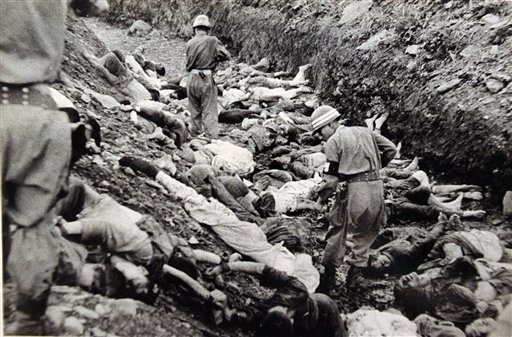
In the work From Occupation to War: Cold War Legacies of US: Army Historical Studies of the Occupation and Korean War, Seoul National University professor Chung Yong Wook writes that "a divergent understanding" of this era "was repressed or rooted out by force in the US and around the ‘free world'" due to the official U.S. history of the war being written in the context of the emerging Cold War. Military historian Richard Robinson, who wrote a work critical of the U.S. role in Korea, Betrayal of a Nation, was unable to find a publisher for his work and it remained in manuscript form. I.F. Stone's work The Hidden History of the Korean War (1952) which was also critical of U.S. conduct in Korea was removed from many libraries. Professor Chung notes that "military historians were not, in essence, allowed to criticize information given to them, nor did they have leeway in interpreting and critiquing facts, they were left only to describe sanitized history" at all stages of the information-gathering and history-writing process.[21]
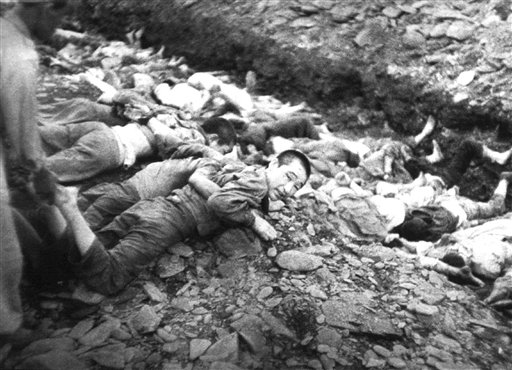
According to Richard Robinson, who had been working as a historian for the military during the occupation, the official American military history of the occupation is "highly prejudiced and inaccurate" adding that the official U.S. histories were "written upon explicit orders not even to imply criticism of anything American" and says that "if the truth were known, the American occupation of South Korea was incredibly bungled by an incompetent and corrupt administration—all in the name of American democracy." Robinson had his work suppressed as he expressed criticism of the U.S. military government's failures in Korea and eventually was compelled to leave the country.[21][22]
Western civilian eyewitnesses of the Korean War, many of them leftists who published their eyewitness accounts as well as interviews and letters from captured soldiers behind North Korean lines, also had their work suppressed. In a research article entitled "Civil Liberties in the Korean War" appearing in the journal Modern Law Review, Ewing, et. al. write, "The atrocities committed by the US-led UN forces are beyond dispute [...] Almost as shameful as the atrocities in Korea were the extreme steps taken to silence and eventually to punish those who sought to expose them." According to their research, the British government threatened eyewitnesses reporting on what they had seen in Korea with allegations of treason, which would have carried a death sentence. The British government also refused to renew some of these witnesses' passports, such as that of Alan Winnington, author of the pamphlet "I Saw the Truth In Korea," whose passport the government did not restore for 14 years. Others subjected to silencing and intimidation tactics by the British government include women's movement activist Monica Felton, solicitor Jack Gaster, and journalist Michael Shapiro. Korean War eyewitness and Australian journalist Wilfred Burchett also had his passport revoked for several years due to his critical reporting, which included reporting on Korea.[23]
Ewing, et. al. write in "Civil Liberties in the Korean War":
What the experience of Winnington, Felton and Gaster expose is the importance of the administrative power of the state to threaten, intimidate and punish. That power could hardly be greater than in the use of treason as a weapon [...] Despite intimidation of the most appalling kind, Winnington, Felton and Gaster have left a body of work that is now of great contemporary significance, and it is work to which we may be encouraged to return if we are fully to understand the modern crisis in Korea. Those who need to read this work most urgently, however, are the ministers and officials in the government departments that so aggressively abused legal authority, unsuccessfully to deny the British people information about the full scale of the atrocities alleged to have been committed in their name.[23]
Alan Winnington's reports of mass executions of political prisoners, reported in the Daily Worker, were denounced as an "atrocity fabrication" by the U.S. Embassy in London, although the Daejeon Massacre, of which he made a report including photos of the mass graves, has since been proven true, with additional abundant photographic evidence now available. CIA and U.S. military intelligence documents were circulating before the Winnington report, but were classified as "secret" and have since been declassified. These reports told of the executions that Winnington had reported on.[24]
A 2008 article in the Telegraph states that British journalist James Cameron wrote about mass prisoner shootings in the South Korean port city of Busan in the fall of 1950, but publisher Edward Hulton ordered the story removed at the last minute. The article further states that in 1953, after the war ended in stalemate, after the deaths of at least 2 million people, half or more of them civilians, "a US Army war crimes report attributed all summary executions here in Daejeon to the 'murderous barbarism' of North Koreans" and adds that "Such myths survived a half-century, in part because those who knew the truth were cowed into silence."[25]
The Telegraph article also comments on the suppression of the narrative concerning the mass killings conducted by South Korean forces, sometimes under U.S. supervision at the outbreak of the Korean War in 1950, as well as "cases in which the U.S. military is accused of the indiscriminate killing of South Korean civilians in 1950-51, usually in air attacks." Regarding the suppression of such realities, the article states "Through the postwar decades of South Korean right-wing dictatorships, victims' fearful families kept silent about that blood-soaked summer. American military reports of the South Korean slaughter were stamped 'secret' and filed away in Washington. Communist accounts were dismissed as lies." The article notes that it was not until South Korean truth commissions began investigations that the truth started to come out after the 1990s, sometimes prompted by chance discoveries of mass graves unearthed by natural disasters, stating that "corroboration comes from a trickle of declassified U.S. military documents" and refers to the hiding of this information as a "long-running cover-up."[25]
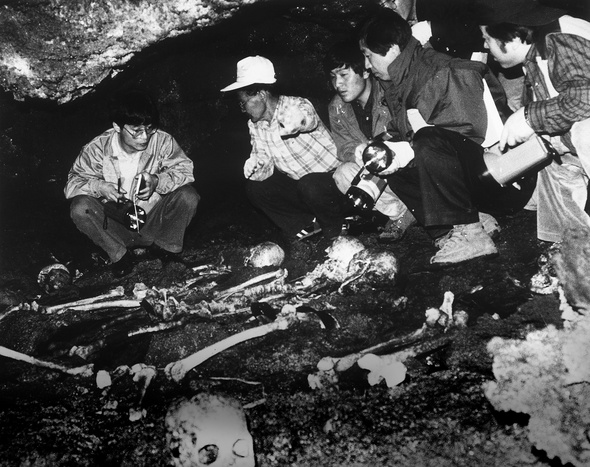
An article in the Asia-Pacific Journal notes that "Even educated South Koreans remained ignorant of their country's past. As a young researcher in the late 1980s, Yonsei University's Park Myung-lim, today a leading Korean War historian, was deeply shaken as he sought out confidential accounts of those days from ordinary Koreans. "I cried," he said. "I felt, 'Oh, my goodness. Oh, Jesus. This was my country? It was true?'". As a doctoral student in the late 1980s, when South Korea's right-wing dictatorship was beginning to weaken somewhat, Park was among the few scholars to begin researching the mass killings. He was regularly harassed by the police. Previous attempts at exposing the killings, mainly by groups of aggrieved families of the victims, saw their leaders arrested and punished.[24]
The facts of the Jeju massacre, which occurred from 1948-49, just prior to the Korean War, were also officially suppressed for decades, only coming to light in January 2000 when a Special Act was decreed by the South Korean Government calling for an official investigation of the incident. According to researcher Kim Hun Joon in The Massacres at Mt. Halla: Sixty Years of Truth Seeking in South Korea, "the massacres were systematically hidden from the general public, and calls for truth and justice were totally suppressed under consecutive anti-Communist military regimes until 1987."[27]
Author Hyun Ki Young is noted in an article from The Jeju Weekly as being credited with writing the first public mention of the Jeju massacre in a 1978 short story. According to the article, Hyun "was unofficially arrested and tortured after the story’s publication," this being one example of the kind of violent suppression measures taken to silence mentions of the massacres in South Korean history. The article quotes Hyun and describes his experience with violent political repression:
“After the publication of his story he attended a protest with a friend of his. They were both arrested. “I was tortured for three days. I was tortured by the NIS [the Korean equivalent to the CIA],” said Hyun. There were two men, one holding Hyun from behind while the other beat him, threatening him to not write about the massacre again. In the booth of the restaurant Hyun, slight in stature, demonstrated how he was restrained and mimicked taking blows to his ribs. They made sure not to break his bones, he said. “If bones were broken there would be problems.” Evidence that this unofficial arrest and torture occurred. Technically Hyun had committed no crime. If they arrested him there would have to be a trial, one that would expose to the rest of Korea the truth of the Jeju Massacre.”[28]
On the topic of general censorship during the Korean War era, author Jeffrey Kaye writes that "When it comes to documents from the period of the Korean War, most Americans are totally unaware that during the 1950s and first half of the 1960s, the U.S. government 'engaged in wholesale confiscation of publications mailed into this country' from Communist countries. This meant any materials emanating from North Korea, China, the Soviet Union or other allied countries (such as those in East Europe at that time) were intercepted and destroyed by U.S. postal officials."[29] In his article, he cites a 1959 article in the University of Pennsylvania Law Review, "Foreign Communist Propaganda in the Mails: A Report on Some Problems of Federal Censorship" which deals with this policy in detail, stating that "thousands of publications containing 'foreign political propaganda' are intercepted on arrival in this country and destroyed. Precisely how much is destroyed and precisely what is destroyed (e.g., by title) remain somewhat a mystery because security policies censor much information on this censorship program." After listing a number of examples of the very broad application of this policy, which resulted in the seizure of many non-propaganda foreign materials as well as the loss of many "irreplaceable" materials that could have been used for academic study of international affairs, the authors state that "The total impact of this censorship on American, culture, science and research during this period can hardly be estimated in any quantitative way [...] It would seem unnecessary, here and now, to labor the point that what happened from 1951 to 1955 was unfortunate and undesirable as a matter of national policy--even if that policy is to be formulated in terms of the most narrow national self-interest."[30]
References[edit | edit source]
- ↑ Lee Jae-Bong (2009-02-07). "US Deployment of Nuclear Weapons in 1950s South Korea & North Korea's Nuclear Development: Toward Denuclearization of the Korean Peninsula" The Asia-Pacific Journal. Archived 2022-08-19.
- ↑ “Sexual slavery carried on even after the fall of the Empire of the Rising Sun, resurrected by the South Korean army during the Korean War. It is perhaps of some significance that the ROK Army was, at the time, dominated at its highest levels by Koreans who had served in the Japanese Imperial Army, some of whom had even served in army units tasked with hunting down Kim Il-sung. Is it any surprise, then, that this very same army, with its historical connections to the Japanese through its officer corps, should set up a Japanese-style system of sexual bondage? It’s also of significance that at the time, the South Korean army was, as it has been throughout its history, under the operational control of a US commander. Hence, the United States was complicit in the sexual slavery practiced by the ROK Army”
Stephen Gowans (2018). Patriots, Traitors and Empires: The Story of Korea’s Struggle for Freedom (p. 33). [PDF] Baraka Books. - ↑ People's Democracy Party and Liberation School. “70 Years Too Long: The Struggle to End the Korean War – Liberation School.” Liberation School – Revolutionary Marxism for a New Generation of Fighters, 25 June 2020. Archived.
- ↑ "The United Nations in Korea." Harry S. Truman Library. Archived 2022-08-19.
- ↑ "Liberation from Japan in 1945." Jeju 4.3 Peace Foundation. Archive.
- ↑ "Still fighting for Korea’s liberation: An interview with Ahn Hak-sop" (Jul 27, 2022). Liberation School. Archived from the original on 2022-08-19.
- ↑ 7.0 7.1 Ernie Trory. "The Invasion of North Korea" New Worker. Archived from the original on 2022-03-05.
- ↑ 8.0 8.1 8.2 8.3 Stephen Gowans (2018). Patriots, Traitors and Empires: The Story of Korea’s Struggle for Freedom: 'The Campaign of 1950-1953' (pp. 123–128). [PDF] Montreal: Baraka Books. ISBN 9781771861427 [LG]
- ↑ “Not an unfounded concern if we consider January of 1952. To reverse the stalemate in military operations in Korea, Truman entertains a radical idea which he records in his diary: they could deliver an ultimatum to the USSR and the People’s Republic of China, clarifying in advance that failure to comply “means that Moscow, Saint Petersburg, Mukden, Vladivostok, Peking, Shanghai, Port Arthur, Dairen, Odessa, Stalingrad, and all the industrial centers of China and the Soviet Union would be eliminated.”
Domenico Losurdo, David Ferreira (2020). Stalin: The History and Critique of a Black Legend (p. 120). [LG] - ↑ "Korea: The End of 13d" (1957-07-01). Time Magazine. Archived 2022-07-28.
- ↑ Lee Jae-Bong (2009-02-07). "US Deployment of Nuclear Weapons in 1950s South Korea & North Korea's Nuclear Development: Toward Denuclearization of the Korean Peninsula" The Asia-Pacific Journal. Archived 2022-18-19.
- ↑ Flounders, Sara. “Faced with U.S. ‘Decapitation Drill’/DPRK Korea Missile Launch Is Self-Defense.” Workers World. August 26, 2022. Archived 2022-10-14.
- ↑ "제국의 제재 - Sanctions of Empire." Nodutdol. October 20, 2020. PDF. Archive.
- ↑ “Because the total armed forces of the ROK were under the complete control of the US until 1994, the US could deploy hundreds of thousands of troops from the south Korean army to Indochina, where they would fight for the US in the Vietnam War. Since then, the ROK has maintained control of their armed forces except in wartime, when a US general is required to take over. This has not stopped tens of thousands of ROK troops from being deployed to fight with the US in Iraq and Afghanistan. “A military exists to wage war. War-making can be defensive, what it’s supposed to be, or aggressive, what it shouldn’t be, but almost invariably is where the United States is concerned. Andrew Bacevich, a US historian and retired career US Army officer, points out that the function of the US military is not self defense, but ‘power projection’—the use, or threat, of violence to impose Washington’s will on other countries. Self-defense is what Homeland Security does. Washington’s granting the ROK control of Washington’s Power Projection Platform in the Pacific 155 the South Korean military in peacetime, i.e., when it’s not fulfilling its primary power projection function, is tantamount to the United States yielding control of an asset when it’s not in use but insisting on full command when it’s needed. In other words, Washington’s ceding peacetime operational control of its East Asian army in reserve—a military which has been historically used as a US auxiliary power projection force in Korea, Vietnam, Afghanistan and Iraq—was nothing more than a sop to mollify South Koreans”
Stephen Gowans (2018). Patriots, Traitors and Empires: The Story of Korea’s Struggle for Freedom (pp. 154-155). [PDF] Baraka Books. - ↑ 15.0 15.1 15.2 15.3 Becker, Brian. “From Inter-Imperialist War to Global Class War: Understanding Distinct Stages of Imperialism – Liberation School.” Liberation School – Revolutionary Marxism for a New Generation of Fighters. July 20, 2018. Archived 2022-10-14.
- ↑ Xiaoming Zhang (2002). Red Wings over the Yalu: China, the Soviet Union, and the Air War in Korea. Texas A&M University Press.
- ↑ Rosemary Foot (1990). A Substitute for Victory: The Politics of Peacemaking at the Korean Armistice Talks (pp. 207–208). Ithaca: Cornell University Press.
- ↑ Andrea Andreen, et al. (1952). Report of the International Scientific Commission for the Investigation of Facts Concerning Biological Warfare in Korea and China. Beijing.
- ↑ 19.0 19.1 Talmadge, Eric. “64 Years after Korean War, North Still Digging up Bombs.” AP NEWS. Associated Press. July 24, 2017. Archived 2023-03-13.
- ↑ Sherry, Michael (September 10, 1989). The Rise of American Air Power: The Creation of Armageddon, p. 287 (from "LeMay's interview with Sherry," interview "after the war," p. 408 n. 108). Yale University Press. ISBN-13: 978-0300044140.
- ↑ 21.0 21.1 Chung, Yong Wook. From Occupation to War; Cold War Legacies of US Army Historical Studies of the Occupation and Korean War. Korea Journal, vol. 60, no. 2 (summer 2020): 14–54. doi: 10.25024/kj.2020.60.2.14 © The Academy of Korean Studies, 2020. URL: https://kj.accesson.kr/assets/pdf/8518/journal-60-2-14.pdf Archive URL. Suppression of counter-narratives ("Abstract" p. 15, PDF p.1); "sanitized history" (p. 20, PDF p. 7)
- ↑ 김환균 (2004-08-09). "'미국의 배반'이 미국에서 금서가 된 이유. (Why "American Betrayal" is Banned Reading in the U.S.)" 미디어오늘 (Media Today). Archived from the original on 2022-07-24.
- ↑ 23.0 23.1 Ewing, K. D., Mahoney, J., & Moretta, A. (2018). "Civil Liberties and the Korean War." Modern Law Review, 81(3), 395-421. https://doi.org/10.1111/1468-2230.12339 Archive.
- ↑ 24.0 24.1 Charles J. Hanley & Jae-Soon Chang (July 2, 2008). "Summer of Terror: At least 100,000 said executed by Korean ally of US in 1950" The Asia-Pacific Journal. Archived from the original on 2022-08-26.
- ↑ 25.0 25.1 “Death Squads and Mass Graves: The Full Horror of the Korean War, Finally Unearthed" 19 May 2008. Telegraph. Archived 2022-08-26.
- ↑ "Darangshi Cave Unearths yet More Jeju Massacre Tragedy." 2012-03-23. Jeju Weekly. Archived 2022-09-04.
- ↑ Kim, Hun Joon. (2014). The Massacres at Mt. Halla: Sixty Years of Truth Seeking in South Korea. Cornell University Press.
- ↑ Darryl Coote (2012.11.20). "My Dinner With Hyun Ki Young" The Jeju Weekly. Archived 2022-08-26.
- ↑ Jeffrey Kaye (2021-01-06). "Massive Mail Censorship Program Hid North Korea Accusations of U.S. BW, Collaboration with Unit 731 War Criminals" Medium. Archived from the original on 2022-08-26. Retrieved 2022-08-26.
- ↑ Shwartz, Murray L., and Paul, C.N. James. "Foreign Communist Propaganda in the Mails: A Report on Some Problems of Federal Censorship." 1959. University of Pennsylvania Legal Scholarship Repository. Archived 2022-08-26.
